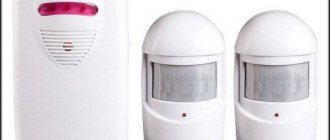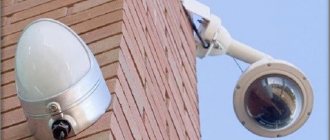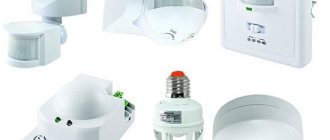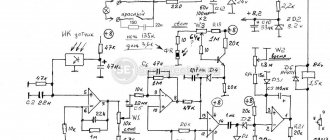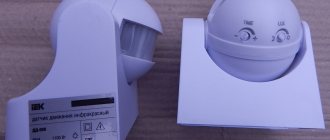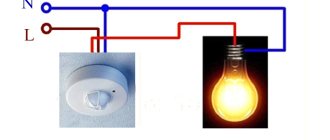In the last article we looked at the general principle of operation of such a sensor and even touched on the technical side. Now let's look at what types there are, their pros and cons.
Currently, the following types of motion sensors are most widespread:
1.Infrared motion sensors (IR)
2. Ultrasonic motion sensors (US)
3. Microwave motion sensors (MW)
4. Combined motion sensors
Each of these types of motion sensors has its own strengths and weaknesses and is used in different situations and conditions.
What is a motion sensor and why is it needed?
Finder motion sensors are special wave detectors powered by electricity. It detects movements in the room. That is, any moving object entering the coverage area of the motion sensor activates the sensor system, which transmits it to the mechanism attached to it.
The device will not harm your health and will significantly save energy, and therefore the money that you could pay for it.
This device has many advantages:
Installing a motion sensor in any warehouse will make your life easier. As a rule, in such rooms the switches are located quite far from the entrance. This means that if the room is creatively cluttered, you can easily get injured by tripping over an object.
Multifunctionality is one of the main advantages of motion sensors. Not only is it compact and ideal for any interior, but it can also be wireless, which is convenient. The motion sensor can be used for various purposes, be it opening a gate or signaling.
Peculiarities
The motion sensor is almost never used “by itself”. In offline mode, it simply detects the occurrence of changes in the controlled area, so it must transmit information about this to related devices or software. And they, in turn, will perform user-specified actions:
- turn on street or interior lighting;
- trigger an alarm;
- send alerts and notifications;
- activate this or that equipment;
- change the parameters of climate control systems and other associated devices.
For example, security motion sensors are almost always included in complex remote control security systems. During installation, specialists configure the connection of the components, and the latter interact through a controller provided and configured by the service provider (private or private security). And the sensor for turning on the light, for example, controls the lighting through the central unit.
If the user is a self-installer and purchases system components separately, he must also purchase, install and configure the appropriate central controller. As a rule, along with this, its supplier provides clients with access to a special cloud service, where connections between components and scenarios for their interaction are configured. This approach is followed, for example, by Xiaomi in its “smart home” ecosystem.
Directional pattern
Proper installation and orientation is critical to ensure maximum performance of the instrument. It was stated above that there is a ceiling and wall installation option; This division in itself does not mean that the ceiling sensor cannot be installed on the wall, or vice versa, but efficiency and accuracy may be reduced.
In addition, before choosing a specific model, you should evaluate the geometry of the space where the gadget will be used and clearly define the planned viewing area. If this is neglected, the device after installation may not “see” movement in the area desired by the owner.
To determine, you should measure the desired viewing angle and the distance at which clear motion detection will be required. Many sensors are equipped with a directional pattern that helps in correct orientation of the device:
Here:
- light area - general viewing area;
- the white dotted line is the area of confident detection.
Types of motion sensors
Now there are several types of motion sensors. Before purchasing, you should understand a little about the characteristics of these devices. There are a large number of them so that everyone can choose a device that suits their specific requirements.
Motion sensors are divided into several types, depending on the location where it is located:
- Type internal. This type of sensor is located indoors. You can install it absolutely anywhere in your house or apartment.
- External type. Such a device operates at a distance of 100 to 500 meters. They are usually installed in the courtyard of a house or in large areas of various industries.
The installation, like the devices, is divided into two types:
- Ceiling installation type. This alarm device is mounted in the ceiling. Typically, it works 360 degrees.
- Wall-mounted or, another name, corner type of installation. The advantage is considered to be a smaller opening angle, which reduces the number of false reactions.
The power supply of the alarm is divided into several types:
Wired power supply – they work well throughout the entire period of operation, almost like new. This happens because electricity is transmitted through wires. The alarm has a minus - it turns off if there is no electricity.
Autonomous or wireless power supply. It runs on one or more batteries that are pre-built. More modern models are powered by sunlight. However, such an environmentally friendly option requires control of electricity. It should not be too little or too much.
Application
Lighting control indoors and outdoors . To automatically turn on lighting in residential premises and outdoors, PIR detectors are mainly used. The range of such sensors is 12 meters.
Some of the models have a limited viewing angle, which helps turn on artificial lighting only at the moment when a person is in the required area.
Modern PIR detectors are equipped with a light sensor, so they do not turn on artificial lighting during daylight hours. This helps save electricity.
Security
In the event of unauthorized entry into the territory of a protected facility, motion sensors are capable of triggering video cameras, alarms, sirens and other necessary devices.
To protect residential premises and offices, IR sensors are usually used; they effectively detect movements in open space. But due to the nature of PIR detector optics, they are not suitable for working in narrow corridors or detecting broken windows. In this case, ultrasonic or microwave detectors are used.
To protect outdoor areas, active and passive infrared detectors, as well as combined devices, are most often used.
For car alarms, microwave sensors and ultrasonic detectors, which are not large in size, are used. – rules for operating security detectors and sensors for switching on electrical appliances.
Installation
The sensors also differ in installation. There are external or overhead ones, as well as devices that are built-in. The first ones are easy to install; you only need to connect electrical wiring to them. The second type has the main advantage of being able to be manufactured to suit the interior and overall design of the room.
To better understand what it looks like, it’s worth looking at photos of such motion sensors. Thanks to this advantage, the sensor can be planned at the design stage of the entire house. Both types differ from each other in their operating principle.
Ultrasonic motion sensor
It works quite simply. The waves that come from the moving object are read by a built-in wave catcher. This type of sensor lasts a long time and is easy to use. The price of the ultrasonic sensor is reasonable and it is also environmentally friendly.
However, it has some disadvantages:
- Often does not respond to slow moving objects.
- It has a negative effect on animals, so if you have pets you should not choose a sensor of this type.
Additional functions
To improve the operation of the system, increase its efficiency and eliminate false alarms, sensors may have additional functions. We have already mentioned a photo relay, which allows the system to be turned off during daylight hours, as well as an additional creep zone sensor. But this list does not exhaust the auxiliary options.
Light off delay
Sensors equipped with a light relay may have a useful function. When a moving object disappears from the field of view, the lighting does not turn off immediately, but with a delay of several tens of seconds. The miniscule excess consumption of electricity pays off in convenience - a person can leave the detector’s coverage area, but not completely leave the controlled area. With this feature, it will not do it in the dark.
Animal protection
Small animals often cause unauthorized activation of sensors. When they appear, turning on the lights is unnecessary, as is the reaction of security. Therefore, some sensors are initially designed to be insensitive to the appearance of small moving objects. In infrared sensors, this function is implemented in the form of a limitation on the minimum size of the thermal spot.
Comparison of the thermal spot from humans and animals in the far zone.
Important! If a small animal moves in the immediate vicinity of the sensor, the angular size of the heat spot may be sufficient to cause a false alarm. Therefore, access to the area adjacent to the sensor installation site should be limited.
Autonomy
If there are problems with organizing power supply for sensors from a household power supply, stand-alone devices may be a good choice. Energy independence is ensured by conventional batteries. Many devices from one galvanic cell operate for several months. In this case, it makes sense to choose sensors with wireless signal transmission in order to completely get rid of cables.
Wireless autonomous sensor Motion Sense 02.
Motion detectors are universal devices. They can be used to build various security, warning and regulation systems. Non-standard use of devices is also possible - everything is limited only by imagination and engineering ingenuity.
Principles of operation of motion sensors
The principle of operation of the motion sensor is quite simple. When a moving object appears in the motion sensor's viewing area, the built-in detector will turn on the relay and with its help, electricity will be transmitted to the light bulbs, thereby turning on the light.
The device operates for the time you specify in the settings. You can select from 5 seconds to 10 minutes. That is, for example, you set a timer for 5 minutes, if there is no movement during this entire time, the device will turn off the light.
- Details about scissor lift
- How to choose a monument?
Why do you need online personnel testing?
Even before purchasing a sensor, you need to decide on its location. The type of device will depend on this. For example, an infrared sensor will not respond to a person if he has not entered the room. If you want the light to turn on when the doors are opened, install an ultrasonic type device.
Model overview
Motion sensors for switching on electrical systems:
«SEN15/LX02"
- LX02
Type – infrared wall sensor;
- Detection zone - 120°;
- Zone length – 12 meters;
- Mains voltage – 230 V;
- Switched load – 1200 W;
- Turn-on time – 10 sec-7 min;
- Installation height – 1.8-2.5 meters;
- Degree of protection – IP44;
- Temperature – from -20 to +40 degrees;
- Price – 320 rubles.
"DD 010"
- Type – wall rotary sensor;
- Detection zone angle - 180°;
- Detection range – 10 meters;
- Mains voltage – 210-240 V;
- Switching power – 1100 W;
- Turn-on time – 5 seconds-6.5 minutes;
- Illumination level – 3-2000 lux;
- Installation height – 1.8-2.2 meters;
- Degree of protection – IP44;
- Temperature – from -20 to + 40 degrees;
- Price – 380 rubles.
Motion sensors for security alarms:
"Astra 5"
- Astra 5
Type – infrared volumetric motion detector;
- Detection zone angle – 90°;
- Range – 12 meters;
- Anti-sabotage zone – yes;
- Sensitivity adjustment – yes;
- Supply voltage – 12 V;
- Relay contacts are normally closed;
- Price – 550 rubles.
"Argus 3"
- Type – high sensitivity radio wave sensor;
- The area of the detection zone is at least 20 m2;
- Adjustable range – 2-8 meters;
- Supply voltage – 10.5-15 V;
- Price – 870 rubles.
Sensors of this type can be installed in rooms where it is necessary to localize a small detection zone. This is achieved by adjusting the operating range.
How to install a motion sensor correctly?
You already know what a motion sensor is, their types, and how they work. Now let's talk about how to properly connect a motion sensor. When placing the device, be sure to take into account the size of the room where the windows and doors are located. All this affects the correct operation of the sensor.
Consider these factors when installing the device:
- There should be no dirt or dust.
- Any objects in front of the sensor, especially outdoors, can cause the device to trigger.
- If you are installing an alarm with wiring, its insulation must be moisture resistant.
- Mounting the sensor next to or opposite devices that emit light or electromagnetic waves is not a good idea.
- Set the desired angle and direction, because the device will react to objects that fall within the coverage area.
- Select lamps according to power, take with a margin of 15%.
So now you know everything there is to know about motion sensors. I hope after reading this article, you have decided for yourself which motion sensor is better to choose.
Adjustment (setting)
After installation, the motion sensor must be configured to turn on the light. There are small rotary controls on the body to adjust almost all parameters. They can be turned by inserting your fingernail into the slot, but it is better to use a small screwdriver. Let us describe the adjustment of a DD-type motion sensor with a built-in light sensor, since they are most often installed in private homes to automate street lighting.
Tilt angle
For those sensors that are mounted on walls, you first need to set the angle of inclination. They are mounted on rotating brackets, with the help of which their position changes. It must be selected so that the controlled area is the largest. It is impossible to give exact recommendations, since it depends on the vertical viewing angle of the model and on the height at which you hung it.
Adjusting the motion sensor begins with selecting the angle of inclination
The optimal installation height for the motion sensor is about 2.4 meters. In this case, even those models that can cover only 15-20° vertically control sufficient space. Adjusting the incline is a very rough name for what you'll be doing. You will gradually change the angle of inclination, check how the sensor works in this position from different possible entry points. It's not difficult, but it's tedious.
Sensitivity
On the body this adjustment is labeled SEN (from English sensitive - sensitivity). The position can be changed from minimum (min/low) to maximum (max/hight).
Basically, the settings look like this
This is one of the most difficult settings, since it determines whether the sensor will work on small animals (cats and dogs). If the dog is large, it will not be possible to avoid false alarms. With medium and small animals this is quite possible. The setup procedure is as follows: set it to minimum, check how it works for you and for inhabitants of smaller stature. If necessary, increase the sensitivity little by little.
Delay time
Different models have different shutdown delay ranges - from 3 seconds to 15 minutes. You need to insert it the same way - by turning the adjusting wheel. It is usually signed Time (translated from English as “time”).
Glow time or delay time - choose what you like best
Everything is relatively easy here - knowing the minimum and maximum of your model, you can approximately choose a position. After turning on the flashlight, freeze and note the time after which it will turn off. Next, change the position of the regulator in the desired direction.
Light level
This adjustment relates to the photo relay, which, as we agreed, is built into our motion sensor to turn on the light. If there is no built-in photo relay, it simply will not exist. This adjustment is labeled LUX, the extreme positions are labeled min and max.
They can be located on the front or back side of the case
When connecting, set the regulator to the maximum position. And in the evening, at the level of illumination when you think the light should already turn on, turn the regulator slowly to the min position until the lamp/lantern turns on.
Now we can assume that the motion relay is configured.



